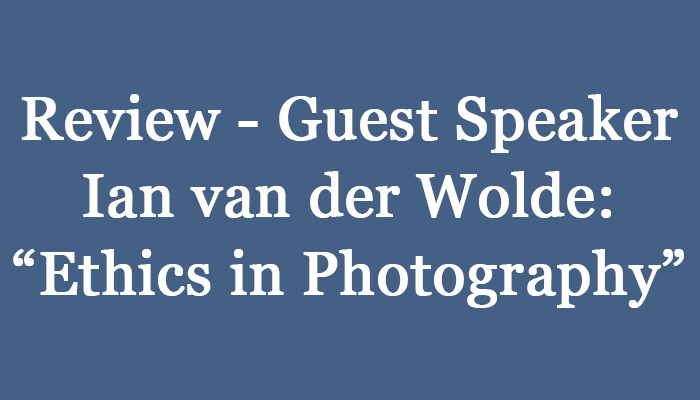As part of Melbourne Camera Club’s Thursday guest speaker program, Ian van der Wolde presented his talk “Ethically Speaking…,” to members and other enthusiasts from VAPS affiliated Clubs across Victoria.
Drawing on 35 years of experience in becoming one of Australia foremost commercial photographers with expertise in compliance, Ian provided some important clarifications about the tricky domain of making ethical decisions in photography. His talk was particularly helpful in distinguishing plagiarism from copyright, and users rights.
Plagiarism
You might consider your work plagiarised when someone recreates an image you have created and claims it as their own idea. But the creation of ‘similar’ work does not constitute an infringement. Copyright in Australia does not protect the ideas you come up with, nor the styles and techniques you might use to execute them. Although not a legal offence it is still offensive when someone plagiarises your work – it’s a moral breach.
Nevertheless, an astute competition judging committee can make themselves aware of the originality of your image/s and can disqualify pretenders as not ‘original’.
On the other hand, Ian cautioned about being blinded by our ego and self righteous indignation when an image taken by someone else resembles an image we took great pride in creating. We might be attracted to the compelling composition and internal lighting of the spiral stairwell at the Vatican for example, but so too have many other photographers.
Copyright
Under Australian law, Copyright was designed “to protect the creator or owner of a creation or image from unauthorised copying or duplication,” Ian said. Under these laws we don’t have to copyright our images – that happens automatically. We own the images we create “throughout our lives and 70 years after,” he added. As such copyright can be sold or bequeathed to others.
There are two broad exceptions when copyright does not apply to the creator. Firstly, when a work is created by an employee of a business as part of that person’s job. And secondly, when the photograph is commissioned for private purposes such as a wedding. Although the client might hold copyright, the photographer does have the right to restrain the number of times your images are used and the purpose to which they are put.
Copyright infringement occurs when your images are copied without your consent and used in ways you did not agree to. Copyright would be breached for example, if I saw your photograph on line and I took a screen copy and put it on my website as my own, or, if the innocent family photo you posted of your dad holding hands with his granddaughter was used as a poster for anti-paedophilia campaign.
A constant refrain through Ian talk was that: “an agreement or contract prior to a work engagement should be created to avoid any misunderstanding or attempted claim at a later date.”
Usage rights (Licence)
Ian explained that user rights are not the same thing as copyright – people often confuse the them. As copyright owners you have the right to sell or pass on user rights to someone else. Ian said that a licensing agreement gives you the right to specify how someone can use your images, for how long, and if you can re-sell your images to someone else. “It about having control over your images and where they go,” Ian said.
In conclusion, Ian’s central message was that it is in everybody’s interest to operate ethically and within the legal frame of copyright law. You might think ethics is dry but Ian added a little tonic with plenty of anecdotes to ginger things up. I would recommend watching his talk in the MCC video library, if you were not able catch it on the night.
In addition, Ian provided the following link to a video from AIPP Contracts and Copyright for Photographers and Video operators, link: www.vimeo.com/452406175
Ian van der Wolde website: https://www.alteredimages.com.au
By Helen Lang
The video will be available on the Members video library page soon.

